Recent surveys show that 68% of homeowners consider their deck an essential extension of their living space. You’ll transform your outdoor area into a vibrant oasis by strategically incorporating plants through vertical gardens, hanging displays, and built-in features. Whether you have a compact 10×12 deck or an expansive 400-square-foot space, these nine plant-focused decorating ideas will help you maximize every inch while creating the perfect balance of beauty and functionality. Let’s explore how to turn your deck into the natural retreat you’ve always wanted.
Contents
- 1 Create a Vertical Garden Wall for Maximum Impact
- 2 Design a Multi-Level Container Garden Display
- 3 Arrange Hanging Baskets in Cascading Patterns
- 4 Establish Privacy Screens With Tall Planters
- 5 Mix Edible and Ornamental Plants in Raised Beds
- 6 Style Corner Clusters With Varied Plant Heights
- 7 Set up a Living Canopy With Climbing Plants
- 8 Incorporate Built-in Planter Benches
- 9 Layer Plant-Filled Window Boxes Along Railings
Create a Vertical Garden Wall for Maximum Impact
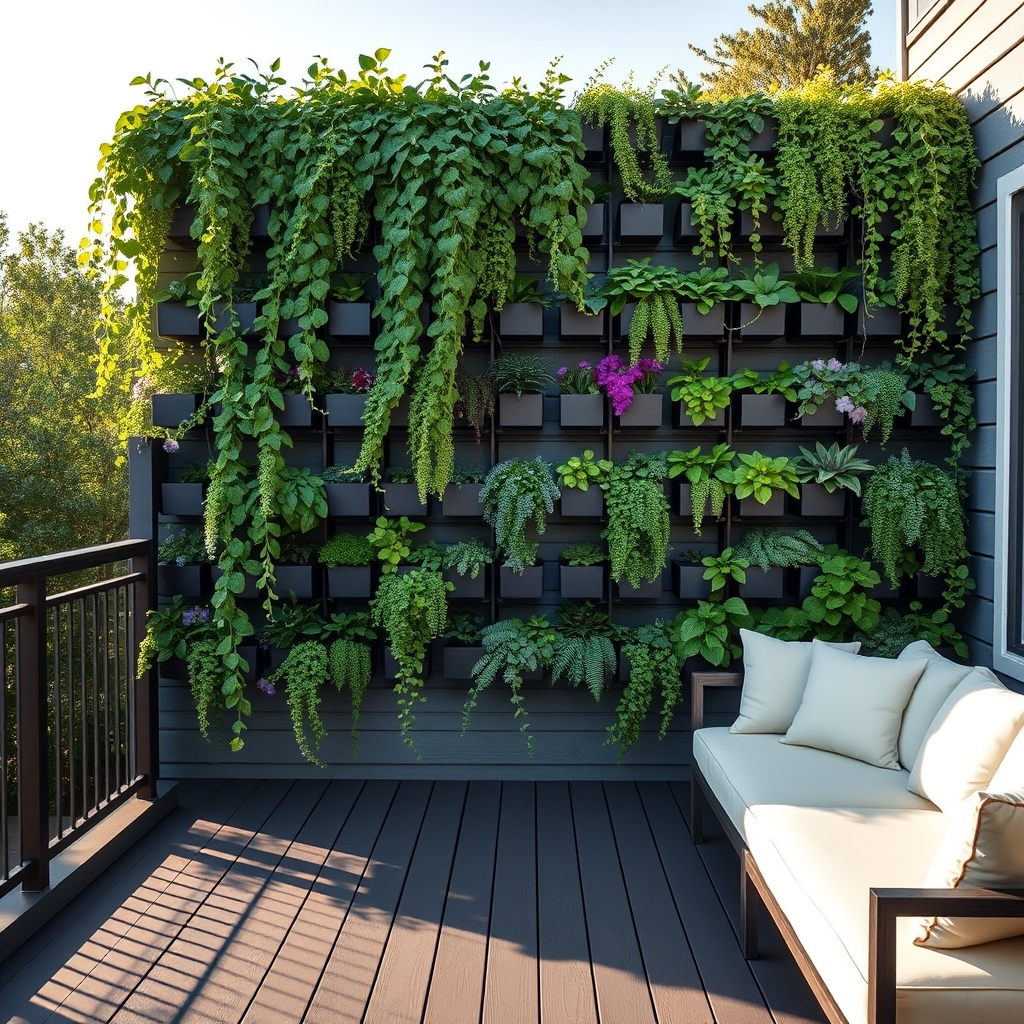
A vertical garden wall transforms an ordinary deck wall or railing into a living tapestry of plants, creating a dramatic visual focal point while maximizing limited deck space.
This space-saving solution features plants arranged in multiple tiers using mounted planters, pocket systems, or modular panels specifically designed for vertical gardening.
Plants cascade downward or grow upward, creating layers of foliage and potentially flowers at different heights.
The unique feature of this design lies in its ability to incorporate a diverse range of plants—from succulents and herbs to trailing vines and compact flowering species—while keeping the deck’s floor space open for furniture and foot traffic.
Design a Multi-Level Container Garden Display

A multi-level container garden display creates visual interest on a deck by arranging plants at various heights using different-sized containers, plant stands, shelving units, or tiered structures.
This layered approach maximizes vertical space while creating depth and dimension, similar to a living wall of greenery. Plants are strategically positioned with taller specimens at the back, medium-height plants in the middle, and trailing varieties in front or along edges.
The design can incorporate wooden crates, metallic planters, or repurposed furniture to achieve varying elevations, while coordinating container styles maintain a cohesive look.
This arrangement allows for better air circulation between plants and makes it easier to view and maintain each specimen while adding architectural interest to the deck space.
Arrange Hanging Baskets in Cascading Patterns
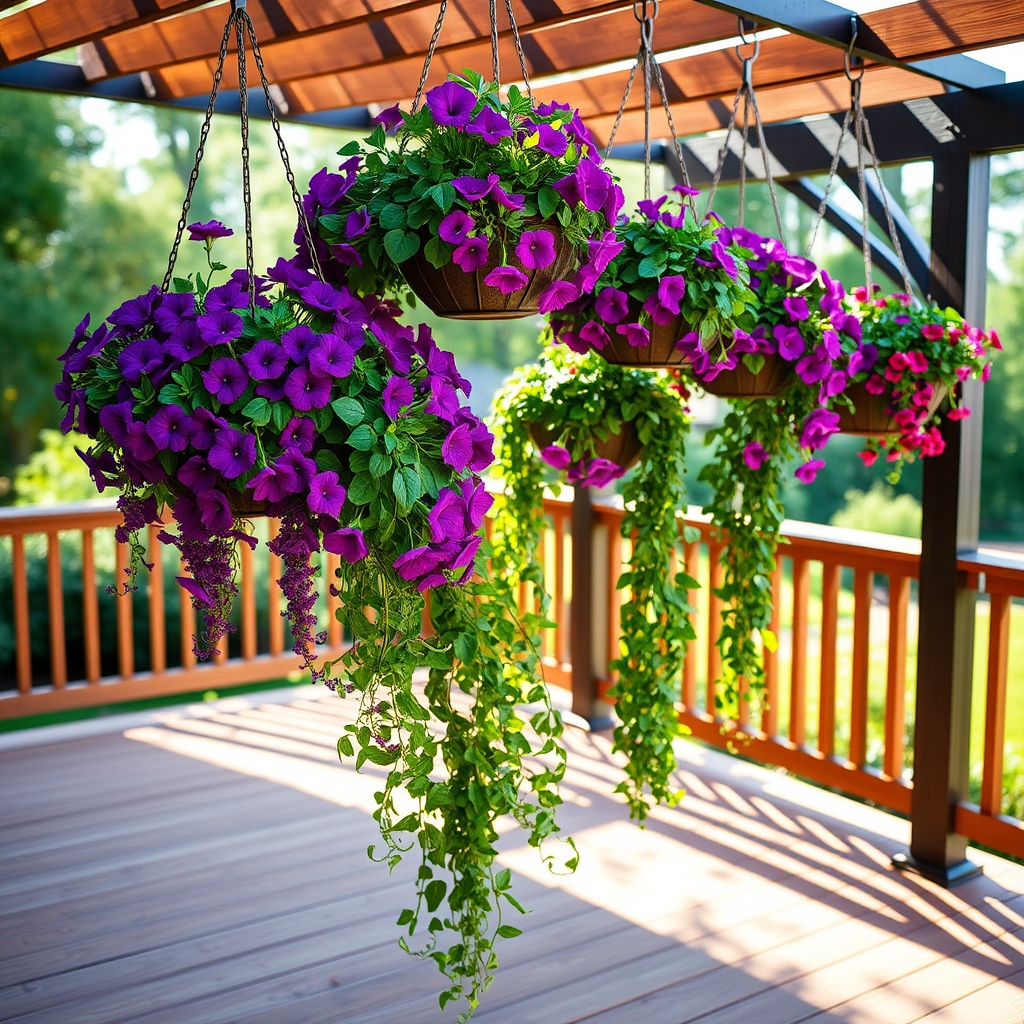
Cascading patterns of hanging baskets create a multi-level display of flowing plants that adds visual drama and dimension to deck spaces.
Plants are arranged in graduated heights, with baskets suspended at different levels from deck railings, overhead beams, or specialized hanging systems. The design typically features trailing plants like petunias, ivy, fuchsia, or verbena that spill downward, creating natural curtains of foliage and blooms.
This arrangement maximizes vertical space while establishing an elegant waterfall effect of greenery. Multiple baskets can be positioned in zigzag or diagonal patterns to achieve full coverage and create a lush, garden-like atmosphere on the deck.
Establish Privacy Screens With Tall Planters

Tall planters strategically placed along deck edges create natural privacy barriers through vertical gardening.
These elevated containers can hold bamboo, ornamental grasses, or climbing vines that grow upward to form living screens. The planters themselves come in various materials like wood, metal, or composite materials, typically standing 3-6 feet tall with adequate depth for root systems.
When arranged in a row or grouped formation, they establish distinct outdoor rooms while maintaining an organic feel.
Plants can be layered at different heights within the containers for added density and visual interest, effectively blocking unwanted views while adding lush greenery to the deck space.
Mix Edible and Ornamental Plants in Raised Beds
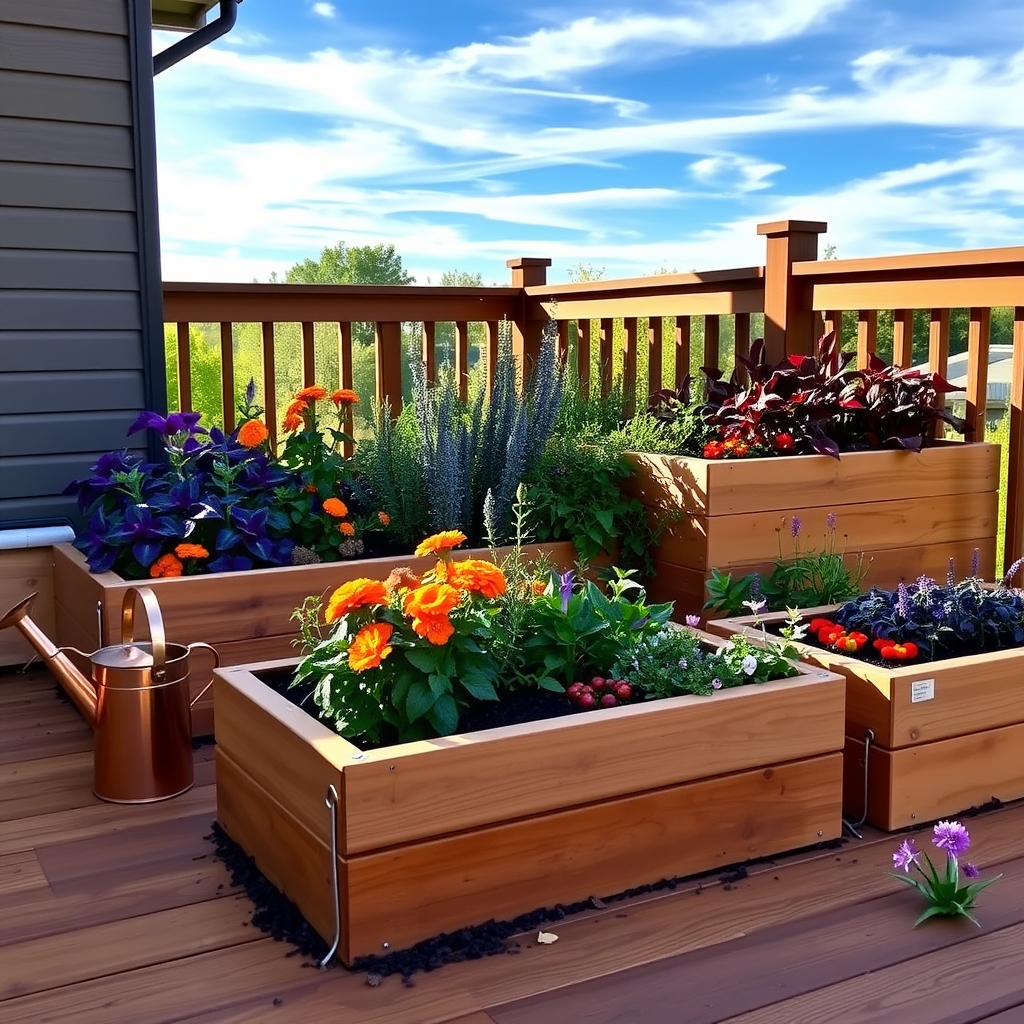
Combining edible and ornamental plants in raised beds creates a visually appealing and functional deck garden space. This approach pairs aesthetic flowers and decorative foliage with vegetables, herbs, and fruits in elevated planters.
Colorful vegetables like rainbow chard, purple basil, or cherry tomatoes grow alongside flowering plants such as marigolds, lavender, or nasturtiums. The raised beds themselves can be constructed from wood, metal, or composite materials, typically standing 1-3 feet tall for easy access.
This dual-purpose planting strategy maximizes limited deck space while providing both beauty and edible harvests throughout the growing season. Strategic placement of taller plants in back and shorter ones in front creates depth and visual interest in the raised bed displays.
Style Corner Clusters With Varied Plant Heights
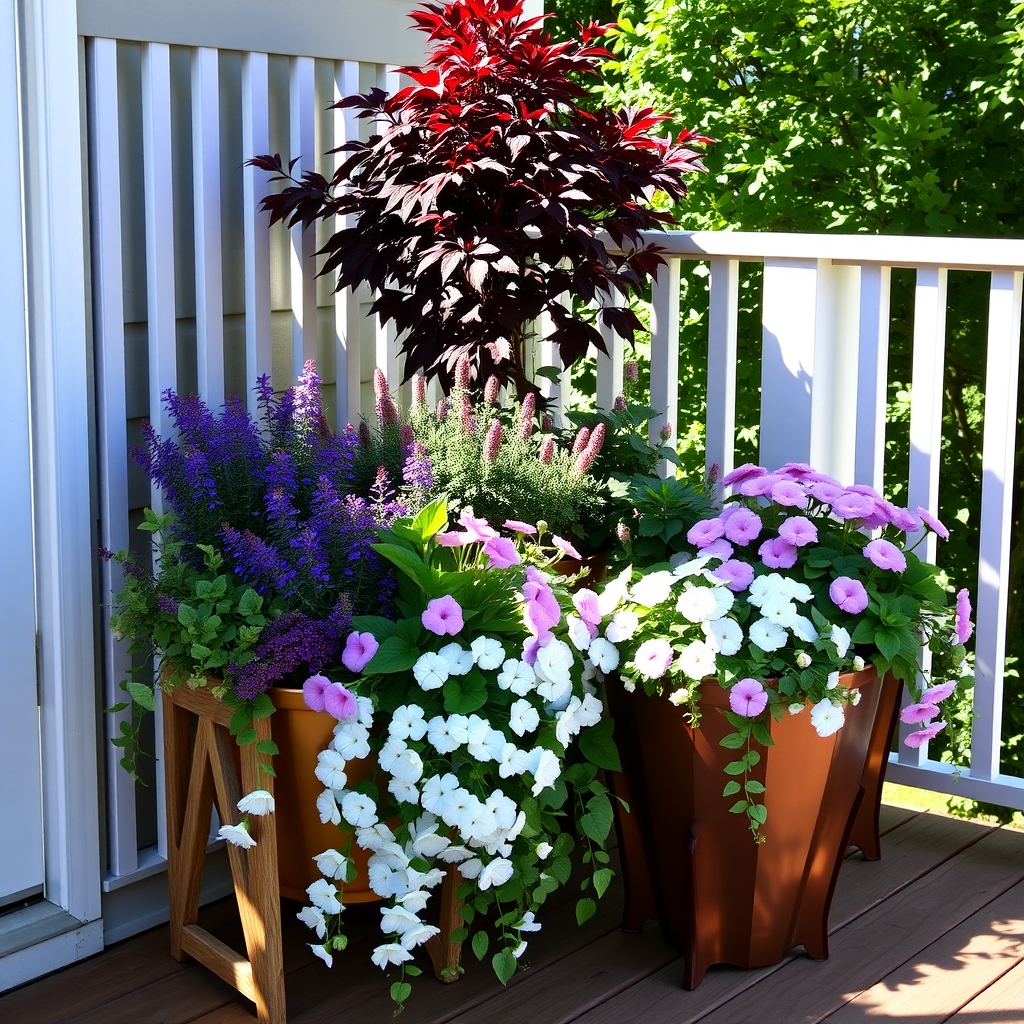
Corner clusters create visual impact by arranging plants of different heights in deck corners, typically following a “thriller, filler, spiller” design principle.
Tall plants like ornamental grasses or small trees serve as the backdrop, while medium-height flowering plants fill the middle ground, and trailing varieties cascade over the edges.
This layered approach adds depth and dimension to deck corners while maximizing vertical space.
Strategic placement of containers at varying elevations using plant stands or tiered shelving further enhances the dramatic effect of these graduated height displays.
Set up a Living Canopy With Climbing Plants
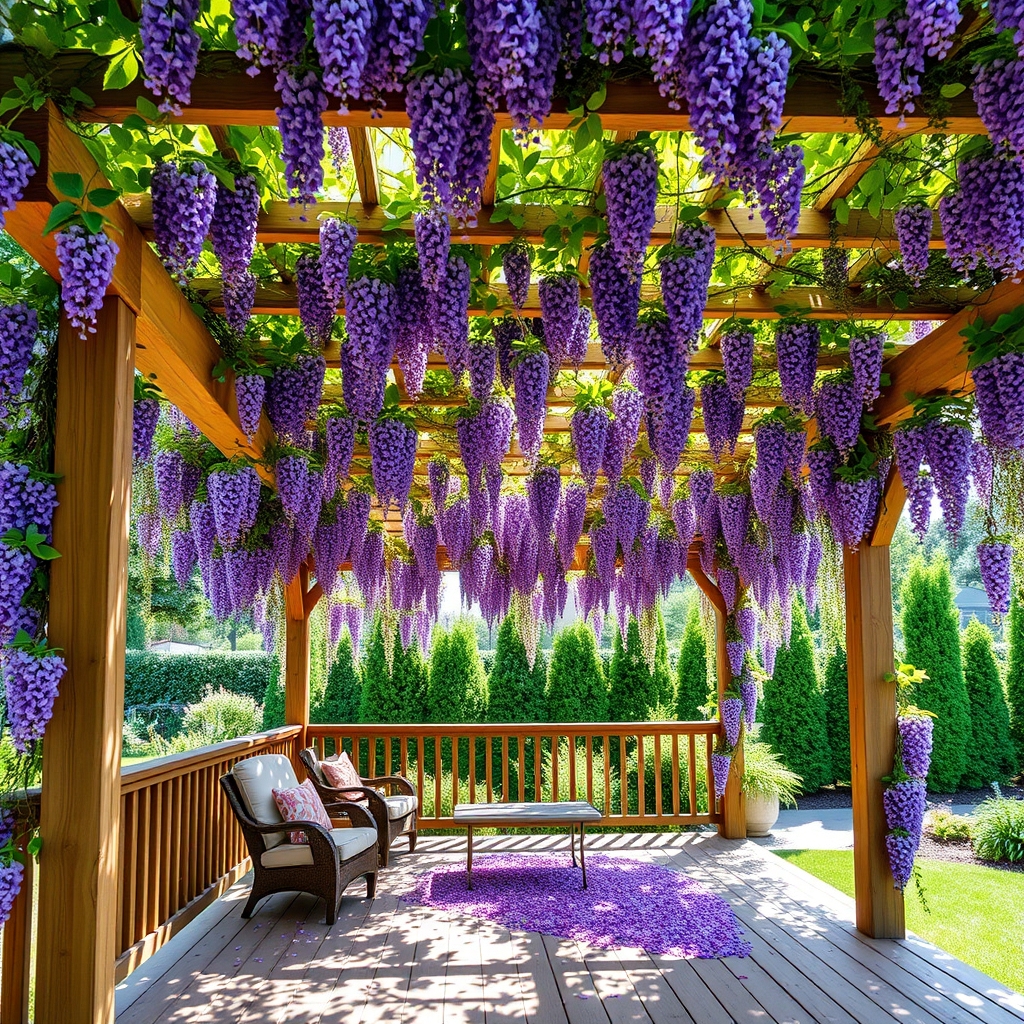
Living canopies created with climbing plants transform deck spaces into lush, shaded retreats. Vines and climbing plants grow upward along trellises, pergolas, or wire systems, eventually forming a natural ceiling of foliage overhead.
This green canopy provides natural shade while adding vertical interest to the deck area. Popular climbing plants like wisteria, climbing roses, clematis, or grape vines can be trained to create this living roof effect, offering seasonal changes through flowers, fruits, and fall colors.
The structure requires sturdy support systems and regular maintenance to guide plant growth and prevent overcrowding.
Incorporate Built-in Planter Benches

Built-in planter benches combine seating and greenery in one functional design element for deck spaces.
These structures typically feature wooden or composite bench seating attached to raised planter boxes, creating an L-shaped or linear arrangement along deck edges.
The planter portion sits behind or beside the seating area, allowing plants to grow and cascade around the bench.
This dual-purpose solution maximizes limited deck space while providing both comfortable seating and a dedicated area for growing flowers, herbs, or ornamental plants.
The integrated design creates a seamless, architectural look and eliminates the need for separate planters and furniture pieces.
Layer Plant-Filled Window Boxes Along Railings
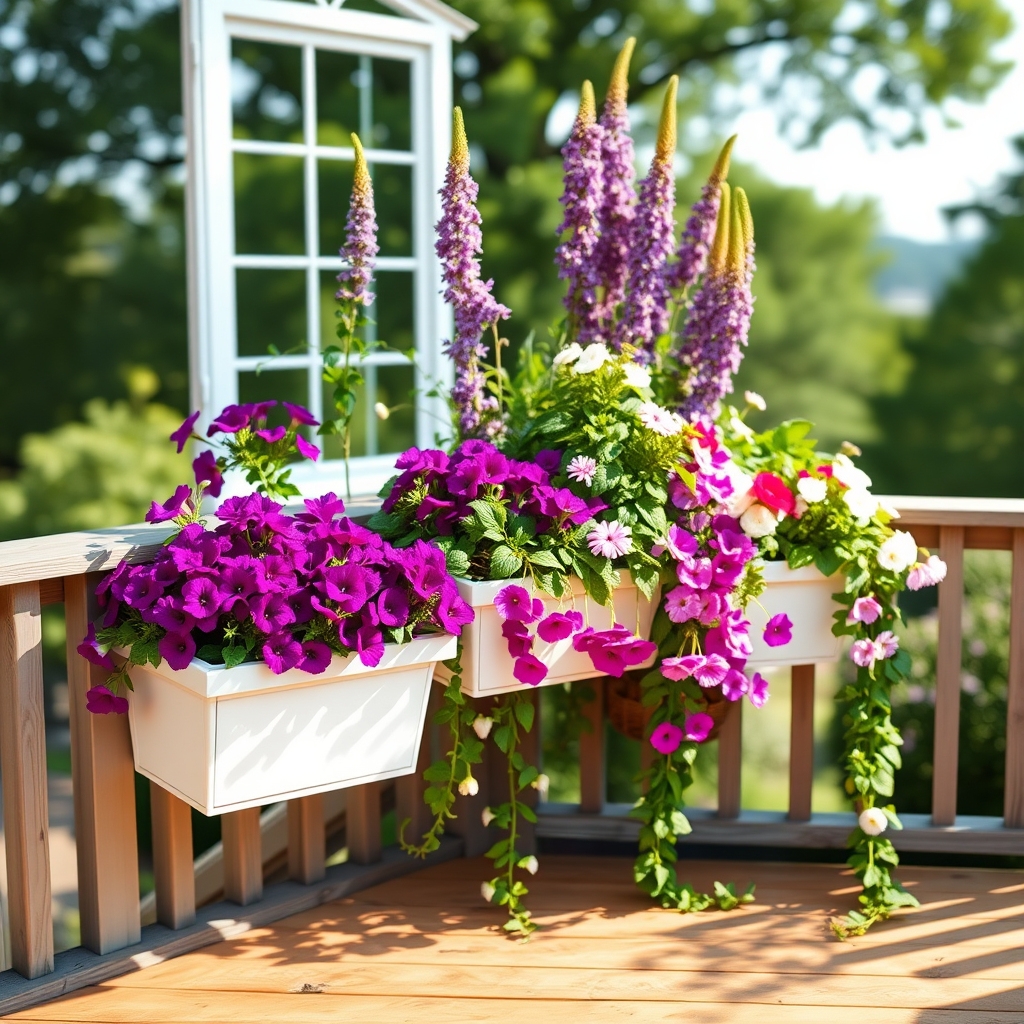
Layer Plant-Filled Window Boxes Along Railings creates a cascading garden effect by mounting window boxes directly onto deck railings.
These boxes typically feature a mix of trailing plants that spill over the edges and upright plants for height variation. The arrangement allows for multiple tiers of greenery, with boxes installed at different heights or staggered along the railing length.
This design maximizes growing space while maintaining deck functionality, and the elevated planters bring flowers and foliage to eye level.
The window boxes can be filled with seasonal blooms, herbs, or decorative grasses, creating a living privacy screen and adding visual interest to the deck’s perimeter.
